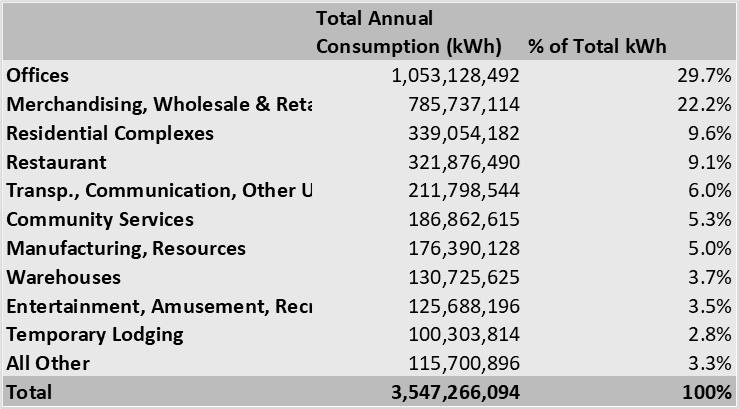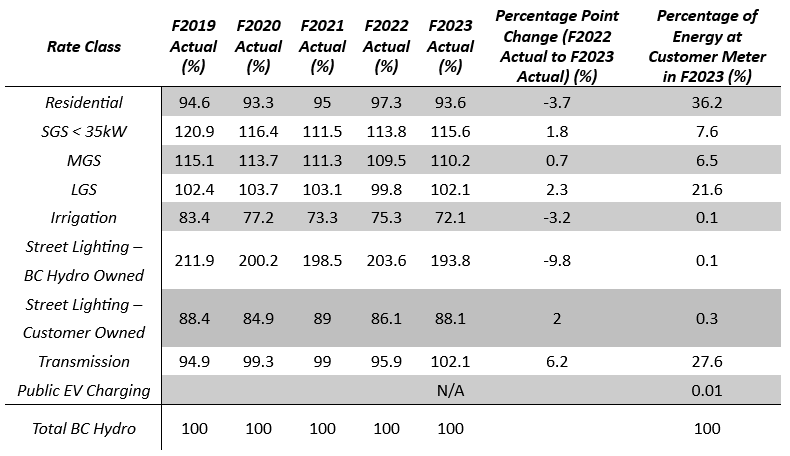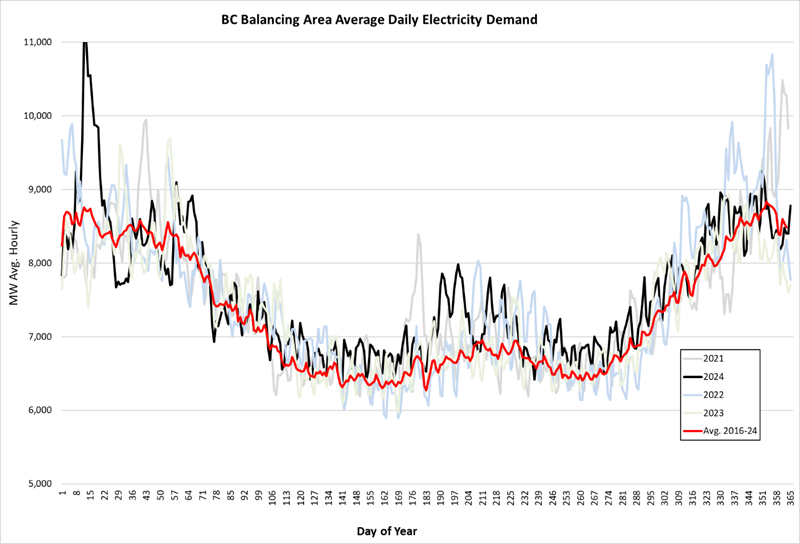REDUCING ELECTRIC BILLS FOR SMALL BUSINESS AND NON-PROFITS IN BC (2025)
Issue
Small businesses provide employment and services that are the lifeblood of communities across BC. However, cost pressures continue to challenge viable businesses. Electrical energy costs are often a significant cost component of the operations of small businesses. BC Hydro provides electricity to 95% of BC customers and FortisBC Inc. provides electricity services to 5% of BC customers in the Southern Interior region.
Business customers are grouped into three categories: Small General Service, Medium General Service and Large General Service. This policy recommendation specifically relates to the customer class called the “Small General Service” (SGS) sector, which is comprised mostly of small businesses in retail, office, warehousing, entertainment, small manufacturing, non-profits, etc.
For business customers, BC Hydro electricity rate charges depend on the annual peak demand and total annual energy usage. The current SGS rates applied by BC Hydro collect much more revenue from the SGS sector customers than it costs to service them. In total, this results in SGS customers paying up to 20% more, or about $60 million more annually, than it costs to serve them.
The BC Government, BC Utility Commission and BC Hydro all have a role in moving rates for the SGS ratepayers and the whole commercial sector. BC Hydro is planning for a new rate design for the Small General Service (SGS) sector. We are recommending that the new design for rates and revenues for the Small General Service sector be more fair, just and reasonable.
Background
BC Hydro’s Commercial Ratepayer Classes
BC Hydro has three classes of commercial customers for which it has rates applicable to the customer’s consumption of electricity.
These business and commercial customer rate classes[1] are:
- SGS – Small General Service - annual peak demand less than 35 kW
- MGS – Medium General Service - annual peak demand between 35 and 150 kW, and that use less than 550,000 kWh of electricity per year.
- LGS – Large General Service - annual peak demand of at least 150 kW, or that use more than 550,000 kWh of electricity per year.
The rate designs and subsequent rates applied to these rate classes are contained in BC Hydro’s published tariffs, which are approved by the BC Utilities Commission. Information on these rates is available on BC Hydro’s website.[2]
Who are the Small General Class Ratepayers?
“Small General Service” (SGS) sector is comprised mostly of small businesses in retail, office, warehousing, entertainment, small manufacturing, non-profits, etc. See Table 1 below.
For context, the average SGS customer consumption is about the same as a single detached home, with a range from 10 times less to 10 times more. Due to their relatively small size, SGS customers often lack the opportunity for consultation and influence to have their interests and points of view heard.
Table 1: Who are the SGS customers, and how much electricity do they consume? [3]

Electricity Rate Design for Small General Service (SGS) Sector
BC Hydro is planning for a new rate design for the Small General Service (SGS) sector and wants to engage this commercial sector in a consultation about the rate design principles and options being considered. This commercial sector includes small businesses and non-profit organizations (including municipalities, fire & police services, community services, hospitals, schools, and associations like Chambers of Commerce)
The main motivation for the new rate design is to address the costs for the capacity required to serve these customers and potentially move from just an energy charge to an energy charge and a capacity charge.
This is part of signalling the cost and being able to take actions to reduce the requirements for capacity to service the ratepayers in the SGS sector. Reduced need for capacity can lead to substantial cost reductions in the BC Hydro electricity delivery systems, as well as lower rates for customers.
Government policy has shown some interest in supporting the commercial sector as an engine for employment, providing economic benefits to communities, and countering tariff wars with local supply. The Government, BC Utility Commission and BC Hydro all have a role in moving to fairer rates for the SGS ratepayers and the whole commercial sector.
BC Hydro’s Interests in Consultation with Its Ratepayers
BC Hydro is proposing to make an application to the BC Utilities Commission to propose optional SGS rate designs for the SGS class of customers. BC Hydro is also in the middle of a process to engage the commercial sector in a collaborative process and to consult with the commercial sector to better understand their needs and points of view.
They are working with the Commercial Energy Consumer (CEC) Association of BC, which represents commercial sector interests before the BC Utilities Commission to organize engagement with their commercial sector ratepayers. The CEC has recommended working with the BC Chamber of Commerce members to arrange for five regional consultation sessions and is helping to organize that activity.
BC Hydro’s willingness to consult with its customers is a healthy process. The BC Chamber can be a unifying force among the diverse ratepayer subsectors and their associations, to achieve substantial benefits for the SGS sector ratepayers and all commercial sector rate payers.
The Cost and Revenue for BC Hydro Ratepayers
BC Hydro’s revenue collection from rate classes is compared to the costs allocated to the rate class, which provides a ratio indicating whether the rate class is paying more or less than the costs for providing service to the customer. This is called an R/C Ratio (Table 2). The SGS ratepayer class has one of the highest R/C ratios of all BC Hydro rate classes.
Table 2: R/C Ratios & Percentage of Energy Consumption by Customer Classes from 2019 to 2023[4]

The commercial sector customers of BC Hydro represent about 35.7% of the electricity consumption in BC and pay substantially more for their electricity services than other customer classes. The cost allocations and specific revenue collection from the SGS customers are provided in the table below.
Table 3: SGS Fully Allocated Cost of Service in $millions for 2023[5]

The SGS customers are paying approximately $60 million more than it costs to serve them, and have been in this position for many years.
The BC Hydro Rate Design Process & Commercial Customer Opportunity
In 2025, BC Hydro is planning to apply to the BC Utilities Commission for approval of optional rate designs for the SGS commercial customer class. As part of this process, the commercial sector is being provided with the opportunity to collaborate with BC Hydro. This includes providing expertise, insights and feedback on possible rate design options.
By providing advantages to BC Hydro’s electricity system, the SGS customer class can accrue significant benefits.
Optional rate designs are intended to help BC Hydro change how the electricity system operates. In this case, BC Hydro is looking to increase the available system capacity during peak times by reducing customer demand at those times. Capacity savings from commercial customers can help slow the need for additional capital expenditures as the demand for electricity grows. BC Hydro is looking for capacity savings across the province.
Capacity savings are very valuable, and any BC Hydro rate design would be applicable to all SGS customers. BC Hydro believes there is an opportunity for commercial customers to reduce their demand on the BC Hydro system. In turn, BC Hydro is supportive of providing rates designed to lower bills for those willing and able to make these adjustments.
Fortunately, for this new rate design process, BC Hydro will be directly consulting with SGS customers through a BC Chamber of Commerce-aided and direct advocacy process.
Rate Design Principles
As BC Hydro designs optional rates for SGS customers, the following rate design principles are critically important, and BC Hydro should adhere to principles that rate designs need to:
- be simple, convenient and easy to implement.
- encourage the efficient use of electricity and discourage waste.
- improve the fair allocation of costs of providing service between the rate classes.
- be practical for BC Hydro to administer.
- recover revenue and ensure stable bills for all BC Hydro customers.
The goal is to provide SGS customers with choices for how they can reduce their electricity bills.
The Process for Achieving Capacity Savings and Benefits for the Commercial Sector
The process of achieving capacity savings involves reducing peak demand on the BC Hydro electric system components. These peak demands[6] occur in the winter months for the whole BC Hydro system and every day for commercial operations (see figure 1 below).
Figure 1: BC Balancing Area Average Daily Electricity Demand

Innovative strategies for reducing peak capacity demand can lead to substantial savings and lower rates for SGS sector customers and the whole commercial sector.
As seen in Figure 1, the top of the peak is about 11,100 megawatts (MWs), which is what the Site-C project is delivering for $16 billion[7], in addition to 5,100 gigawatt hours of energy. By 2040, BC Hydro expects capacity requirements in the Lower Mainland to increase by over 1000 MWs. For context, this is approximately the capacity needed to serve 450,000 homes.
Therefore, the management of capacity demand and the reduction of capacity requirements can lead to very substantial savings and a lowering of rates and electricity bills for commercial customers.
Conclusions
The commercial sector in general and the SGS customers for this consultation process with BC Hydro should first address the excess revenue collection from commercial customers, and second, enable the opportunities to provide the commercial sector with the equipment and operations required to reduce capacity requirements successfully.
These two initiatives would optimize the benefits to the commercial ratepayer class and represent fair, just and reasonable rate design.
THE CHAMBER RECOMMENDS
That the Provincial Government:
- Direct BC Hydro & the BC Utilities Commission to develop and provide lower, fair, just and reasonable rates to address the excess revenue collection from the Small General Service sector and make it more in line with the costs of serving this group, without disadvantaging other ratepayers.
- Direct BC Hydro & the BC Utilities Commission to develop and implement new innovative rate designs for the Small General Service sector that will provide the incentives, equipment and operations required to reduce capacity requirements, optimize the benefits and reduce the bills for small businesses and non-profits, and support BC Hydro energy management.
[1] These are BC Hydro rate classes. FortisBC Inc also has commercial rate classes, which are regulated by the BC Utilities Commission in separate proceedings from the BC Hydro proceeding. Similar but some different policy issues will be raised in a separate regulatory context and separate advocacy processes.
[3] BC Hydro Supplied Breakdown of Electricity Consumption by Subsector.
[4] BC Hydro’s Fiscal 2023 Fully Allocated Cost of Service (FACOS) Study
[5] BC Hydro’s Fiscal 2023 Fully Allocated Cost of Service (FACOS) Study
[6] BC Hydro Balancing for BC Electricity Demand
[7] British Columbia Utilities Commission (BCUC or Commission), British Columbia Hydro and Power Authority (BC Hydro), Site C Clean Energy Project - PUBLIC Quarterly Progress Report No. 21, June 29, 2021, letter from the President and CEO of BC Hydro to the Chair and CEO of the BCUC.
